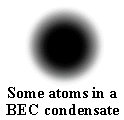BEC - What is it and where did the idea come from?
 What I have heard about Bose-Einstein condensation makes it sound really
weird. What is it really, and how did someone think of it?
What I have heard about Bose-Einstein condensation makes it sound really
weird. What is it really, and how did someone think of it?
 In the early 1920s Satyendra Nath Bose was studying the new idea (at that
time) that the light came in little discrete packets (we now call these
"quanta" or "photons"). Bose assumed certain rules for deciding when two
photons should be counted up as either identical or different. We now call
these rules "Bose statistics" (or sometimes "Bose-Einstein statistics").
In the early 1920s Satyendra Nath Bose was studying the new idea (at that
time) that the light came in little discrete packets (we now call these
"quanta" or "photons"). Bose assumed certain rules for deciding when two
photons should be counted up as either identical or different. We now call
these rules "Bose statistics" (or sometimes "Bose-Einstein statistics").
|

|
 So where does Einstein come in?
So where does Einstein come in?
 Bose had trouble getting people to believe him and to publish his ideas in the
scientific magazines of the day, so he sent them to Einstein. Einstein liked
them, and he was a very important scientist at that time, so he used his
influence to get them published.
Bose had trouble getting people to believe him and to publish his ideas in the
scientific magazines of the day, so he sent them to Einstein. Einstein liked
them, and he was a very important scientist at that time, so he used his
influence to get them published.
 So all he did was use his influence, and for that he got his name on it?
So all he did was use his influence, and for that he got his name on it?
 No, he actually did something else very important. Einstein guessed that these
same rules might apply to atoms. He worked out the theory for how atoms would
behave in a gas if these new rules applied. What he found was that the
equations said that generally there would not be much difference, except at
very low temperatures. If the atoms were cold enough, something very unusual
was supposed to happen. It was so strange he was not sure it was correct.
No, he actually did something else very important. Einstein guessed that these
same rules might apply to atoms. He worked out the theory for how atoms would
behave in a gas if these new rules applied. What he found was that the
equations said that generally there would not be much difference, except at
very low temperatures. If the atoms were cold enough, something very unusual
was supposed to happen. It was so strange he was not sure it was correct.
 I thought Einstein was always right.
I thought Einstein was always right.
 Not in this case. He was only sort of half correct, or maybe a little less.
First, not all types of atoms actually follow the rules for Bose statistics
(stay tuned for our upcoming Bose-Einstein and Fermi statistics page).
However, some atoms do, and for those Einstein's predictions were right. But
even for those kinds of atoms, he did not realize the most important effects
that his equations were predicting.
Not in this case. He was only sort of half correct, or maybe a little less.
First, not all types of atoms actually follow the rules for Bose statistics
(stay tuned for our upcoming Bose-Einstein and Fermi statistics page).
However, some atoms do, and for those Einstein's predictions were right. But
even for those kinds of atoms, he did not realize the most important effects
that his equations were predicting.
 If Einstein missed them, they must have been pretty hard to see. What were
they and how did anyone figure them out?
If Einstein missed them, they must have been pretty hard to see. What were
they and how did anyone figure them out?
 The effects come from the fact that, at very low temperatures, most of the
atoms are in the same quantum level.
The effects come from the fact that, at very low temperatures, most of the
atoms are in the same quantum level.
 Uh, the same quantum level? What does that mean?
Uh, the same quantum level? What does that mean?
 Remember how we talked about how electrons in an atom can only have certain energies which we called the
quantum mechanical energy levels?
Remember how we talked about how electrons in an atom can only have certain energies which we called the
quantum mechanical energy levels?
 Vaguely I guess.
Vaguely I guess.
 If you put an atom in any kind of container, even a mixing bowl, it also can
only have certain particular energies. It cannot roll around in there with
just any speed it wants. It has to choose from a particular set of allowed
energies.
If you put an atom in any kind of container, even a mixing bowl, it also can
only have certain particular energies. It cannot roll around in there with
just any speed it wants. It has to choose from a particular set of allowed
energies.
 That does not make sense. I can put a ball bearing in a bowl and give it any
speed I want. So where are your particular energies?
That does not make sense. I can put a ball bearing in a bowl and give it any
speed I want. So where are your particular energies?
 They are so close together in energy that you never notice there are tiny
steps. What Einstein's equations predicted was that at normal temperatures the
atoms would be in many different levels. However, at very low temperatures, a
large fraction of the atoms would suddenly go crashing down into the very
lowest energy level. The example below shows a model of atoms in a bowl with
greatly magnified energy levels.
They are so close together in energy that you never notice there are tiny
steps. What Einstein's equations predicted was that at normal temperatures the
atoms would be in many different levels. However, at very low temperatures, a
large fraction of the atoms would suddenly go crashing down into the very
lowest energy level. The example below shows a model of atoms in a bowl with
greatly magnified energy levels.
 When I make the temperature low, they are all in the bottom. What does that
mean?
When I make the temperature low, they are all in the bottom. What does that
mean?
 The atoms piling up in the bottom is what we call Bose-Einstein condensation,
and it happens because this demonstration is built to match Einstein's
equations. "What it really means" is probably a question Einstein should have
asked, but did not. He did not realize how weird a material would be with all
the atoms in one level like this. It means that all the atoms are absolutely
identical. There is no possible measurement that can tell them apart.
The atoms piling up in the bottom is what we call Bose-Einstein condensation,
and it happens because this demonstration is built to match Einstein's
equations. "What it really means" is probably a question Einstein should have
asked, but did not. He did not realize how weird a material would be with all
the atoms in one level like this. It means that all the atoms are absolutely
identical. There is no possible measurement that can tell them apart.
 But I can just look and see the different black spots that represent different
atoms. How can they be identical?
But I can just look and see the different black spots that represent different
atoms. How can they be identical?

 Good point. You have just picked out a mistake in this demonstration. Really,
an atom in the lowest energy level is spread out a little, so it looks like a
very small fuzzy ball. When you have lots of atoms in the same state, all
these fuzzy balls lie exactly on top of each other.
Good point. You have just picked out a mistake in this demonstration. Really,
an atom in the lowest energy level is spread out a little, so it looks like a
very small fuzzy ball. When you have lots of atoms in the same state, all
these fuzzy balls lie exactly on top of each other.

 Now I can't tell one atom from another; they are all in the same place. But I
know that atoms don't really do that. I have tables, chairs, and all these
other objects that have their shapes because their atoms are arranged in
different places.
Now I can't tell one atom from another; they are all in the same place. But I
know that atoms don't really do that. I have tables, chairs, and all these
other objects that have their shapes because their atoms are arranged in
different places.
 Now you can see why it was so long before people understood what BEC really
meant. Atoms really can all be in the same place like this, but it goes
against everything we see around us. It is only at the special incredibly low
temperatures needed for BEC that they lose their individual identities and
coalesce into a single blob. Some people have called this a "super atom" for
just that reason.
Now you can see why it was so long before people understood what BEC really
meant. Atoms really can all be in the same place like this, but it goes
against everything we see around us. It is only at the special incredibly low
temperatures needed for BEC that they lose their individual identities and
coalesce into a single blob. Some people have called this a "super atom" for
just that reason.






